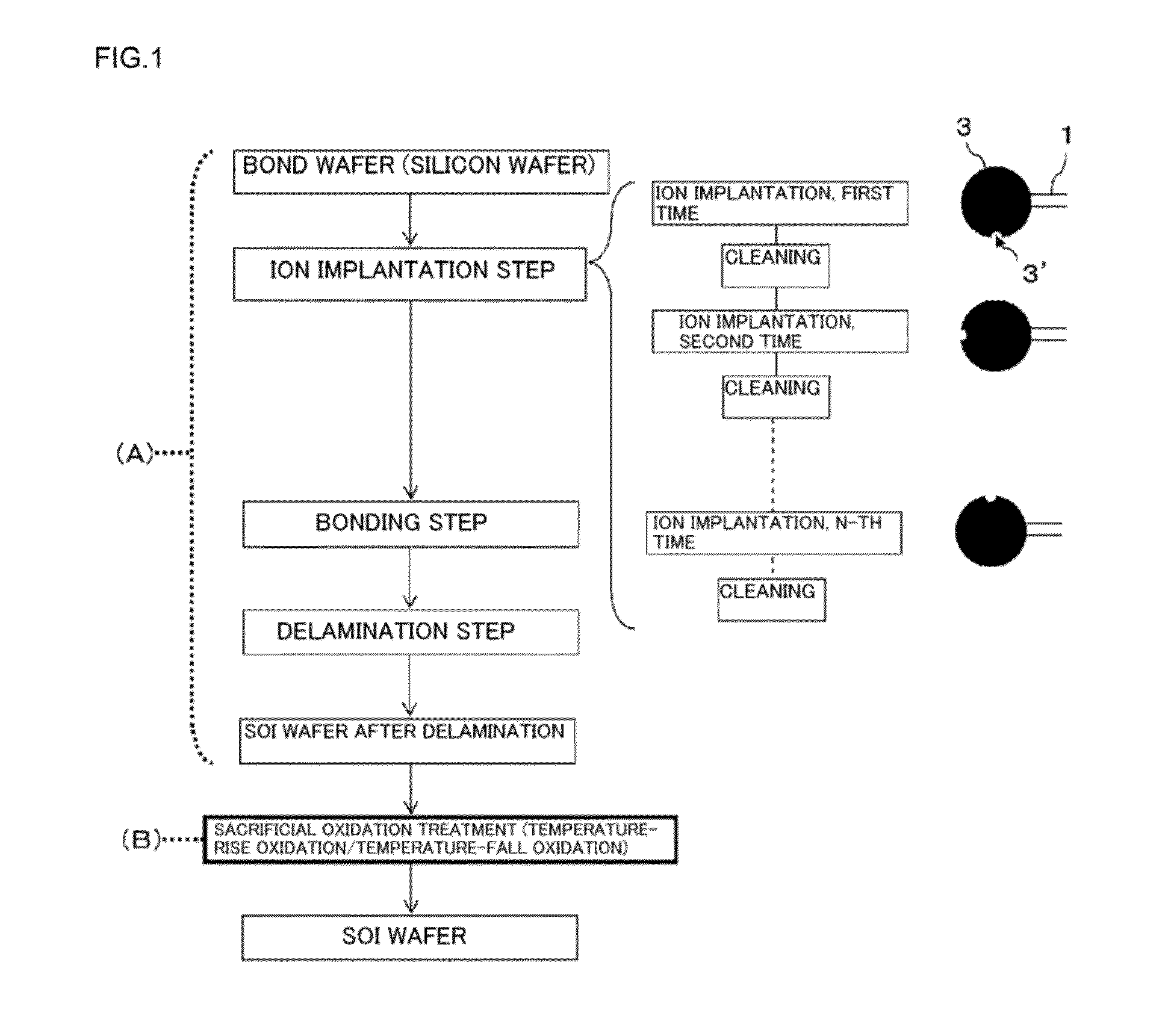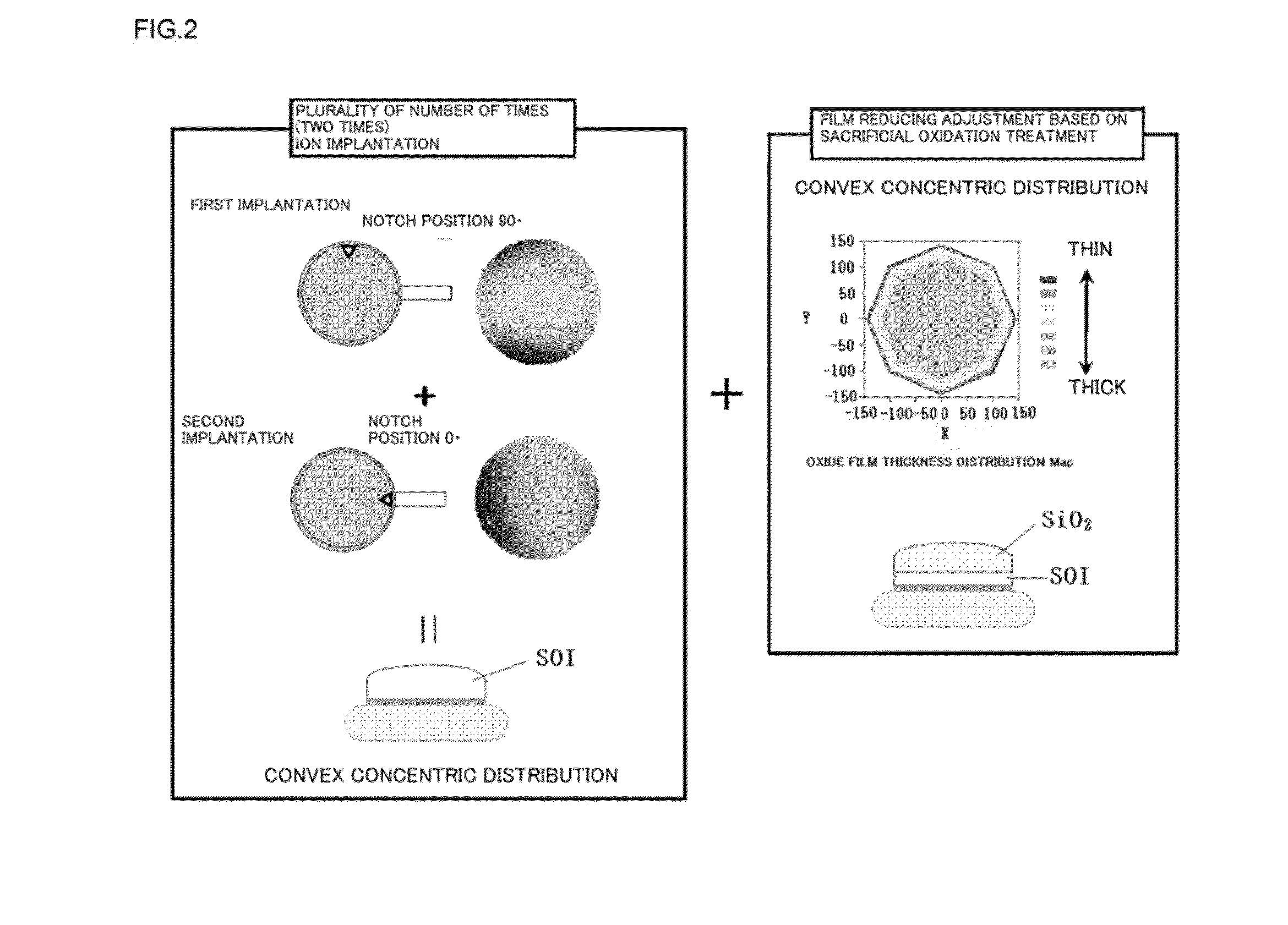Method for manufacturing soi wafer
a technology of soi wafer and film thickness, which is applied in the direction of semiconductor/solid-state device manufacturing, basic electric elements, electric apparatus, etc., can solve the problems of deterioration of the film thickness uniformity of the soi layer achieved by implantation and delamination of hydrogen ions and others, and the surface roughness is considerable, so as to improve the yield of the device and improve the film thickness uniformity
- Summary
- Abstract
- Description
- Claims
- Application Information
AI Technical Summary
Benefits of technology
Problems solved by technology
Method used
Image
Examples
example 1
[0082]In Example 1, a buried oxide film that is 25 nm thick was fabricated on a silicon wafer with a diameter of 300 mm made of silicon single crystal having a crystal orientation (a crystal plane on a surface is precisely (100) without an angular deviation), and then hydrogen ion implantation was carried out. The ion implantation was divisionally carried out in two steps with the use of a batch processing ion implanter, first implantation was performed with H+, 30 keV, 2.6 e16 cm−2, an implantation angle of 0 degree, and a notch orientation angle of 0 degree, and second implantation was effected with H+, 30 keV, 2.6e16 cm−2, an implantation angle of 0 degree, and a notch orientation angle of 90 degrees. After the hydrogen ion implantation, the wafer was bonded to a base wafer and delaminated at a hydrogen ion implanted layer by a nitrogen atmosphere heat treatment performed at 500° C. for 30 minutes. Thereafter, as shown in FIG. 3, a temperature-fall oxidation treatment for contin...
example 2
[0084]After the ion implantation delamination was performed like Example 1, as shown in FIG. 3, the conventional oxidation at a fixed temperature of 900° C. was effected (the thermal oxidation (1)). An oxide film thickness after the thermal oxidation was 250 nm. A concentric distribution was out of shape, and a radial oxide film thickness Range of 0.4 nm. Then, the flattening heat treatment was performed in an Ar atmosphere, the temperature-fall oxidation treatment for continuing the pyrogenic oxidation treatment until 900° C. was carried out during the falling of a temperature after the pyrogenic oxidation treatment effected at 950° C. (the thermal oxidation (2)). A oxide film thickness after the thermal oxidation was 440 nm. A oxide film thickness distribution was measured by using a PW monitor, a radial oxide film thickness Range (Max−Min) provided by the temperature-fall oxidation treatment was 1.4 nm, and a concentric distribution that is thick at a central portion and thin at ...
example 3
[0086]A thin film SOI wafer having an SOI film thickness of 10 nm was fabricated under the same conditions as those of Example 1 except that the thermal oxidation (2) of Example 1 is the temperature-fall oxidation that is the same as the thermal oxidation (2) in Example 2. In regard to a film thickness distribution of a 10-nm SOI, Range was 0.5 nm, and the very excellent radial distribution was obtained.
PUM
| Property | Measurement | Unit |
|---|---|---|
| rotation angles | aaaaa | aaaaa |
| rotation angles | aaaaa | aaaaa |
| rotation angles | aaaaa | aaaaa |
Abstract
Description
Claims
Application Information
 Login to View More
Login to View More - R&D
- Intellectual Property
- Life Sciences
- Materials
- Tech Scout
- Unparalleled Data Quality
- Higher Quality Content
- 60% Fewer Hallucinations
Browse by: Latest US Patents, China's latest patents, Technical Efficacy Thesaurus, Application Domain, Technology Topic, Popular Technical Reports.
© 2025 PatSnap. All rights reserved.Legal|Privacy policy|Modern Slavery Act Transparency Statement|Sitemap|About US| Contact US: help@patsnap.com



